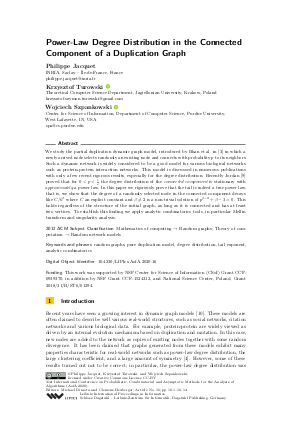Power-Law Degree Distribution in the Connected Component of a Duplication Graph
Authors
Philippe Jacquet,
Krzysztof Turowski  ,
Wojciech Szpankowski
,
Wojciech Szpankowski 
-
Part of:
Volume:
31st International Conference on Probabilistic, Combinatorial and Asymptotic Methods for the Analysis of Algorithms (AofA 2020)
Part of: Series: Leibniz International Proceedings in Informatics (LIPIcs)
Part of: Conference: International Conference on Probabilistic, Combinatorial and Asymptotic Methods for the Analysis of Algorithms (AofA) - License:
 Creative Commons Attribution 3.0 Unported license
Creative Commons Attribution 3.0 Unported license
- Publication Date: 2020-06-10
File

PDF
LIPIcs.AofA.2020.16.pdf
- Filesize: 493 kB
- 14 pages
Document Identifiers
Subject Classification
ACM Subject Classification
- Mathematics of computing → Random graphs
- Theory of computation → Random network models
Keywords
- random graphs
- pure duplication model
- degree distribution
- tail exponent
- analytic combinatorics
Metrics
- Access Statistics
-
Total Accesses (updated on a weekly basis)
0Document
0Metadata
Abstract
We study the partial duplication dynamic graph model, introduced by Bhan et al. in [Bhan et al., 2002] in which a newly arrived node selects randomly an existing node and connects with probability p to its neighbors. Such a dynamic network is widely considered to be a good model for various biological networks such as protein-protein interaction networks. This model is discussed in numerous publications with only a few recent rigorous results, especially for the degree distribution. Recently Jordan [Jordan, 2018] proved that for 0 < p < 1/e the degree distribution of the connected component is stationary with approximately a power law. In this paper we rigorously prove that the tail is indeed a true power law, that is, we show that the degree of a randomly selected node in the connected component decays like C/k^β where C an explicit constant and β ≠ 2 is a non-trivial solution of p^(β-2) + β - 3 = 0. This holds regardless of the structure of the initial graph, as long as it is connected and has at least two vertices. To establish this finding we apply analytic combinatorics tools, in particular Mellin transform and singularity analysis.
Cite As Get BibTex
Philippe Jacquet, Krzysztof Turowski, and Wojciech Szpankowski. Power-Law Degree Distribution in the Connected Component of a Duplication Graph. In 31st International Conference on Probabilistic, Combinatorial and Asymptotic Methods for the Analysis of Algorithms (AofA 2020). Leibniz International Proceedings in Informatics (LIPIcs), Volume 159, pp. 16:1-16:14, Schloss Dagstuhl – Leibniz-Zentrum für Informatik (2020)
https://doi.org/10.4230/LIPIcs.AofA.2020.16
BibTex
@InProceedings{jacquet_et_al:LIPIcs.AofA.2020.16,
author = {Jacquet, Philippe and Turowski, Krzysztof and Szpankowski, Wojciech},
title = {{Power-Law Degree Distribution in the Connected Component of a Duplication Graph}},
booktitle = {31st International Conference on Probabilistic, Combinatorial and Asymptotic Methods for the Analysis of Algorithms (AofA 2020)},
pages = {16:1--16:14},
series = {Leibniz International Proceedings in Informatics (LIPIcs)},
ISBN = {978-3-95977-147-4},
ISSN = {1868-8969},
year = {2020},
volume = {159},
editor = {Drmota, Michael and Heuberger, Clemens},
publisher = {Schloss Dagstuhl -- Leibniz-Zentrum f{\"u}r Informatik},
address = {Dagstuhl, Germany},
URL = {https://drops.dagstuhl.de/entities/document/10.4230/LIPIcs.AofA.2020.16},
URN = {urn:nbn:de:0030-drops-120467},
doi = {10.4230/LIPIcs.AofA.2020.16},
annote = {Keywords: random graphs, pure duplication model, degree distribution, tail exponent, analytic combinatorics}
}
Author Details
Funding
This work was supported by NSF Center for Science of Information (CSoI) Grant CCF-0939370, in addition by NSF Grant CCF-1524312, and National Science Center, Poland, Grant 2018/31/B/ST6/01294.
References
-
Gürkan Bebek, Petra Berenbrink, Colin Cooper, Tom Friedetzky, Joseph Nadeau, and Süleyman Cenk Sahinalp. The degree distribution of the generalized duplication model. Theoretical Computer Science, 369(1-3):239-249, 2006.

-
Gürkan Bebek, Petra Berenbrink, Colin Cooper, Tom Friedetzky, Joseph Nadeau, and Süleyman Cenk Sahinalp. The degree distribution of the generalized duplication model. Theoretical Computer Science, 369(1-3):239-249, 2006.

-
Ashish Bhan, David Galas, and T. Gregory Dewey. A duplication growth model of gene expression networks. Bioinformatics, 18(11):1486-1493, 2002.

-
Fan Chung, Linyuan Lu, T. Gregory Dewey, and David Galas. Duplication models for biological networks. Journal of Computational Biology, 10(5):677-687, 2003.

-
Reinhard Diestel. Graph Theory. Springer, 2005.

-
Philippe Flajolet and Andrew Odlyzko. Singularity analysis of generating functions. SIAM Journal on Discrete Mathematics, 3(2):216-240, 1990.

-
Felix Hermann and Peter Pfaffelhuber. Large-scale behavior of the partial duplication random graph. ALEA: Latin American Journal of Probability and Mathematical Statistics, 13:687-710, 2016.

- I. Ispolatov, P. L. Krapivsky, and A. Yuryev. Duplication-divergence model of protein interaction network. Phys. Rev. E, 71:061911, 2005. URL: https://doi.org/10.1103/PhysRevE.71.061911.
-
Jonathan Jordan. The connected component of the partial duplication graph. ALEA: Latin American Journal of Probability and Mathematical Statistics, 15:1431-1445, 2018.

-
Mark Newman. Networks: An Introduction. Oxford University Press, 2010.

-
PK Pollett. Reversibility, invariance and μ-invariance. Advances in applied probability, 20(3):600-621, 1988.

-
Wojciech Szpankowski. Average Case Analysis of Algorithms on Sequences. John Wiley & Sons, New York, 2001.

-
Krzysztof Turowski, Abram Magner, and Wojciech Szpankowski. Compression of Dynamic Graphs Generated by a Duplication Model. In 56th Annual Allerton Conference on Communication, Control, and Computing, pages 1089-1096, 2018.

-
Krzysztof Turowski and Wojciech Szpankowski. Towards degree distribution of duplication graph models, 2019.

